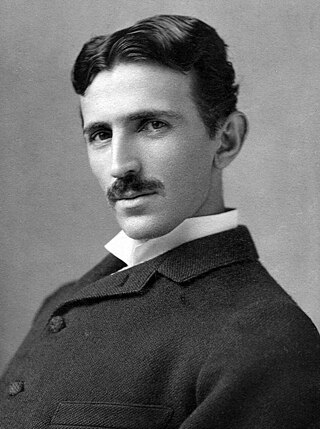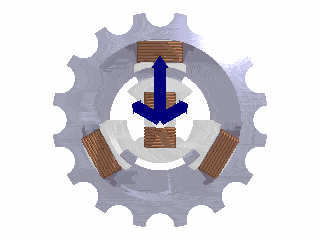
Nikola Tesla was a Serbian-American engineer, futurist, and inventor. He is known for his contributions to the design of the modern alternating current (AC) electricity supply system.

An electric motor is a machine that converts electrical energy into mechanical energy. Most electric motors operate through the interaction between the motor's magnetic field and electric current in a wire winding to generate force in the form of torque applied on the motor's shaft. An electric generator is mechanically identical to an electric motor, but operates in reverse, converting mechanical energy into electrical energy.

In electricity generation, a generator is a device that converts motion-based power or fuel-based power into electric power for use in an external circuit. Sources of mechanical energy include steam turbines, gas turbines, water turbines, internal combustion engines, wind turbines and even hand cranks. The first electromagnetic generator, the Faraday disk, was invented in 1831 by British scientist Michael Faraday. Generators provide nearly all the power for electrical grids.

An alternator is an electrical generator that converts mechanical energy to electrical energy in the form of alternating current. For reasons of cost and simplicity, most alternators use a rotating magnetic field with a stationary armature. Occasionally, a linear alternator or a rotating armature with a stationary magnetic field is used. In principle, any AC electrical generator can be called an alternator, but usually, the term refers to small rotating machines driven by automotive and other internal combustion engines.

An induction motor or asynchronous motor is an AC electric motor in which the electric current in the rotor that produces torque is obtained by electromagnetic induction from the magnetic field of the stator winding. An induction motor therefore needs no electrical connections to the rotor. An induction motor's rotor can be either wound type or squirrel-cage type.

A rotating magnetic field (RMF) is the resultant magnetic field produced by a system of coils symmetrically placed and supplied with polyphase currents. A rotating magnetic field can be produced by a poly-phase (two or more phases) current or by a single phase current provided that, in the latter case, two field windings are supplied and are so designed that the two resulting magnetic fields generated thereby are out of phase.

A polyphase system is a means of distributing alternating-current (AC) electrical power that utilizes more than one AC phase, which refers to the phase offset value between AC in multiple conducting wires; phases may also refer to the corresponding terminals and conductors, as in color codes. Polyphase systems have two or more energized electrical conductors carrying alternating currents with a defined phase between the voltage waves in each conductor. Early systems used 4 wire two-phase with a 90° phase angle, but modern systems almost universally use three-phase voltage, with a phase angle of 120°.

Galileo Ferraris was an Italian university professor, physicist and electrical engineer, one of the pioneers of AC power system and inventor of the induction motor although he never patented his work. Many newspapers touted that his work on the induction motor and power transmission systems were some of the greatest inventions of all ages. He published an extensive and complete monograph on the experimental results obtained with open-circuit transformers of the type designed by the power engineers Lucien Gaulard and John Dixon Gibbs.

A homopolar generator is a DC electrical generator comprising an electrically conductive disc or cylinder rotating in a plane perpendicular to a uniform static magnetic field. A potential difference is created between the center of the disc and the rim with an electrical polarity that depends on the direction of rotation and the orientation of the field. It is also known as a unipolar generator, acyclic generator, disk dynamo, or Faraday disc. The voltage is typically low, on the order of a few volts in the case of small demonstration models, but large research generators can produce hundreds of volts, and some systems have multiple generators in series to produce an even larger voltage. They are unusual in that they can source tremendous electric current, some more than a million amperes, because the homopolar generator can be made to have very low internal resistance. Also, the homopolar generator is unique in that no other rotary electric machine can produce DC without using rectifiers or commutators.
Gordon Richard Slemon, was a Canadian electrical engineer and professor.

An AC motor is an electric motor driven by an alternating current (AC). The AC motor commonly consists of two basic parts, an outside stator having coils supplied with alternating current to produce a rotating magnetic field, and an inside rotor attached to the output shaft producing a second rotating magnetic field. The rotor magnetic field may be produced by permanent magnets, reluctance saliency, or DC or AC electrical windings.
Eugene C. Whitney was a celebrated power engineer who designed hydroelectric turbines and generators at Westinghouse Electric Company. The pinnacle of his career was the machinery for the expansion of the Grand Coulee Dam to add the #3 Powerhouse in 1966–74.
Doubly fed electric machines, also slip-ring generators, are electric motors or electric generators, where both the field magnet windings and armature windings are separately connected to equipment outside the machine.
Peter John Lawrenson, FIEE, FIEEE, FRS, FREng was an Emeritus Professor of Electrical Engineering at the University of Leeds who pioneered and championed the development of switched reluctance drive technology. He also made significant contributions to the analysis and computation of magnetic fields and electrical machines in general, writing several notable text books along with colleagues Kenneth Binns, Martyn Harris and J. Michael Stephenson and latterly with C.W. ("Bill") Trowbridge.

Benjamin Garver Lamme was an American electrical engineer and chief engineer at Westinghouse, where he was responsible for the design of electrical power machines. Lamme created an efficient induction motor from Nikola Tesla's patents and went on to design the giant Niagara Falls generators and motors and the power plant of the Manhattan Elevated Railway in New York City.
In electrical engineering, electric machine is a general term for machines using electromagnetic forces, such as electric motors, electric generators, and others. They are electromechanical energy converters: an electric motor converts electricity to mechanical power while an electric generator converts mechanical power to electricity. The moving parts in a machine can be rotating or linear. While transformers are occasionally called "static electric machines", since they do not have moving parts, generally they are not considered "machines", but as electrical devices "closely related" to the electrical machines.
The IEEE Richard Harold Kaufmann Award is a Technical Field Award of the IEEE that was established by the IEEE Board of Directors in 1986. This award is presented for outstanding contributions in industrial systems engineering.

Dan Mircea Ionel is Professor of electrical engineer, the L. Stanley Pigman Chair in Power, and the Director of the SPARK Laboratory and of the PEIK Institute at the University of Kentucky, Lexington, KY. Professor Ionel's research includes the electric machines, wind turbines, power system, applications of power electronics, smart buildings. By the number of citations, he is among the world top 2% highly cited researchers.

Md. Azizur (Aziz) Rahman was a Bangladeshi born Canadian inventor of modern energy-efficient electric motors that span multiple industry applications. He was an electrical engineer, professor, researcher and scientist. He is internationally recognized as one of the founding innovators of modern power engineering and a pioneer in the development and application of interior permanent magnet motors and associated drive technology-used in the world's first mass-produced hybrid vehicle, the Toyota Prius. Since launching the Prius in 1997, Toyota surpassed global sales of 15 million hybrid vehicles in 2020, all of which use Dr. Rahman's IPM motor drive. His research contributions were broad and adopted in a wide range of electric motor applications ranging from vacuum cleaners, air conditioners, elevators to aircraft.














